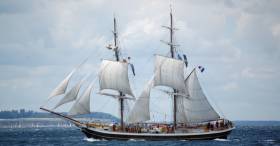Displaying items by tag: Belfast City Council
Belfast City Council Calls for Harland & Wolff Shipyard Support
A motion by Belfast City Council has been passed to call on the UK government to support Harland and Wolff as it faces administration.
As BBC News reports, the council is seeking an urgent meeting with the Northern Ireland secretary to discuss the future of the shipyard.
Harland and Wolff is at risk of closure after its parent company ran into severe financial problems.
It is understood the city shipyard could go into administration as early as Monday, putting 123 jobs at risk.
SDLP councillor Brian Heading said he would have a conference call with Northern Ireland Secretary Julian Smith on Saturday.
At Friday's emergency meeting of Belfast City Council there was cross-party support for the workers and their families, many of whom were seated in the public gallery.
For more on the week-long campaign by the shipyard workers click here.
In addition click to view a webcast of the motion held in the city hall chamber.
Tall Ship Sailing Chance Between Irish & Scottish Ports
Anyone aged between 16 and 28 who would like to sail aboard a Tall Ship is being offered the opportunity by Belfast City Council and Sail Training Ireland. As Afloat.ie previously reported, The Tall Ships, “Maybe” and “Morgenster” are the vessels on which voyages between Belfast, Scottish and Irish ports, will be available, as part of Belfast’s Maritime Festival. Applications are invited with a deadline of Friday, March 25.
Tall Ships Belfast To Raise Money for Charity
#tallshipsbelfast – Sailing and maritime charities are to raise cash from the big summer Tall Ships Spectacular in Belfast this July. The Tall Ships Company Ltd has appointed five key charities who will benefit from the event, according to the Belfast Telegraph. The charities are RNLI Lifeboats, Ocean Youth Trust, The Mission to Seafarers, Sea Cadet Corps and Belfast Lough Sailability.
This is the first time individual charities will be working as a collective and will be holding a variety of fundraising activities leading up to and during the three day extravaganza in Belfast from 2nd to 5th of July.
"It's an amazing event for any city to have," said Gerry Copeland, Belfast City Council City Events Manager.
"In 2009 at the Tall Ships event there were half a million people, and we expect another half a million people at this event."
He added: "Because the ships leave Belfast on 5 July to make their way to Norway, we expect another half a million people along the Antrim coast and the Causeway coast."
The ships will be berthed in and around Belfast Harbour and the Titanic Quarter area.
Meanwhile, an organisation known as the Atlantic Youth Trust has drawn up a plan for a 40m sail training ship for Ireland as the country considers what type of Tall Ship would be best for Ireland.
Belfast to Welcome Tall Ships in 2015
#TALL SHIPS - Ireland will be getting a triple dose of the Tall Ships Races this decade - after Waterford last year and Dublin next summer - as Belfast has been chosen to host the first leg of the event in 2015, BBC News reports.
Belfast City Council made the official announcement this afternoon, with Belfast Lord Mayor Niall O Donnghaile saying the return of the event in July 2015 was "another very real endorsement of Belfast's ability".
Northern Ireland's capital last hosted the tall ships in 2009, when some 800,000 visitors thronged the city to see 40 vessels in a parade of sail.
BBC News has more on the story HERE.



























































